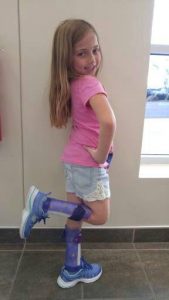
There are many children with SA/CRS who walk. Here are some videos showing exactly that. Some have no outwardly visible signs of the condition when only a small part of the sacrum is missing. Others may walk with a slight limp. They may move more slowly. The joints in their feet may be less flexible. They may have reduced ankle flexibility and reduced muscle in their calves. Some children require surgery to align their feet, allow for some flexion in the knee or otherwise address orthopedic issues. Some children will require bracing support.
Children with less stable pelvic areas and/or with more involvement of the knee and upper thigh will need more extensive support for walking, including walker, crutches, and/or more extensive bracing.
Those who have fixation of joints, bent and webbed at the knee usually are not be able to have their knees straightened enough for walking. Some may opt for at-knee disarticulation that allows for walking with prosthetics.
When the hip flexor muscles are not strong enough, and the pelvic area is also unstable, walking is extremely difficult. Although bracing can support torso, hips and legs, the walking that occurs is done almost entirely using the shoulders and is usually slow and cumbersome. The distance for walking in this manner is limited and rough terrain and stairs may be significant barriers.
Walking for children with SA/CRS is similar to the range and progression seen in walking for children with spina bifida and spinal cord injury except that the instability of the pelvic area is a complicating factor. A fact sheet on walking from the Spina Bifida Association gives an overview of the range of expectations for this population.
Equipment
Standers
Standing frames allow for an individual to stand up and sometimes to also move while standing. This device can be used with individuals who have SA/CRS if there are not flexion contractions at the knees and hips. A parapodium is an orthotic device often used for very young children. Here is an article about the parapodium.
Orthotics
An ankle-foot orthosis (AFO) provides ankle and foot support for those who have good hip and knee strength and can control the knee during standing and movement. Different types of AFOs are available for the type of support the individual needs. They are usually made of molded plastic and inserted into a shoe but some are carbon fiber or metal or a combination of materials. They may be used on one or both feet.
A knee-ankle-foot orthosis (KAFO) provides stability for the knee, ankle, and foot. KAFOs may be made of carbon fiber, plastic, or leather with metal uprights and are usually inserted into shoes. Wearers may need these orthotics for one or both feet.
A hip-knee-ankle-foot orthosis (HKAFO) stabilizes the hip, knee, and ankle. It consists of a pair of KAFOs attached to one another by a pelvic band or trunk orthosis. With the hip component locked, the individual can lift with shoulder muscles and torso for a swing to/through gait pattern with a walker or crutches. With the hip component unlocked, the user may be able to ambulate with a reciprocal gait. HKAFOs may be carbon fiber, plastic, or leather with metal bars and locks. They may be attached to shoes or inserted into shoes; they are more difficult to take on or off than the orthoses listed above, especially when they include the bilateral leg pelvic attachment.
A reciprocating gait orthosis (RGO) is a pair of HKAFOs that are connected to one another by an isocentric bar and a cable system, allowing the user to ambulate with a reciprocal gait using by shifting body weight to one side and then the other. A shift to one side activates the movement of the opposite side. This orthosis may be attached to shoes or used as an insert into shoes. It may be difficult to take on or off because they are attached at the waist/pelvis and on both legs.
Prosthetics
For children who have had at-knee disarticulation, prosthetics molded to fit around the upper leg can be attached to locking KAFOs. Depending on the child’s pelvic stability, a molded torso brace may also need to be attached to the prosthetics. Similar to the HKAFO, the child walks using shoulder lifts for a swing to or swing through gait, or may use a reciprocal gait with a twisting motion at the hips. For children with one leg affected and disarticulated, a single prosthetic is often very effective for functional, independent walking. For children with good hip stability and balance, the prosthetic may allow for functional walking without the use of a walker or crutches.
Therapy
Locomotor training (LT) is a type of therapeutic modality involving continuous repetition of the lower extremities to complete a meaningful task such as walking. For childrens with SA/CRS, this may involve moving the legs and feet in a walking motion. Some children move their legs and feet together rather than in a stepping motion.
Physical therapy often begins with increasing balance and strength of the torso as well as locomotor training of the legs. Crawling, pulling to a stand, and learning to fall are all part of the process for early walking. Some children may be able to progress through stages of walking without use of additional equipment, while others benefit from use of a walker or crutches and the types of bracing described above. A therapist may work with a child in parallel bars and guide the child’s stepping movements. Once ambulation is accomplished in the parallel bars, use of a walker that rolls forward when pushed may be used. Once the child has mastered the walker, a goal may be to use forearm crutches.
Mobility choices and options
Walking for many children with SA/CRS requires a great deal of energy. As size and body weight increase over time, walking can become more difficult. It is often recommended that a wheelchair be included as an option for longer distances. As children grow and have both options, they are able to decide which option is most effective for them for specific tasks. Being able to make the choice for the mobility option that allows for the most independence and function is an important part of a child’s development.
